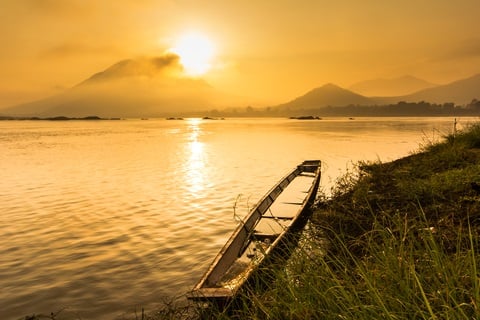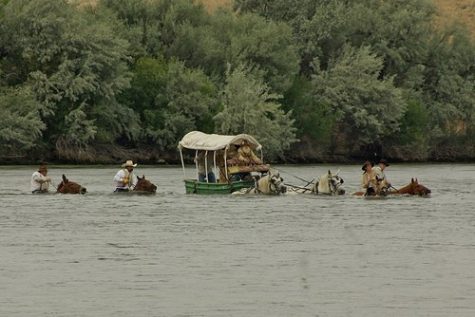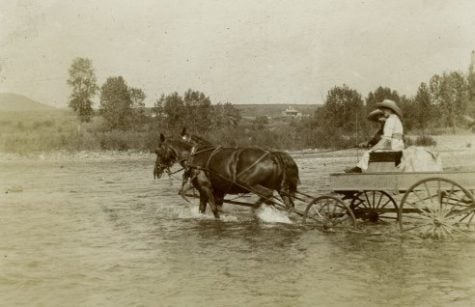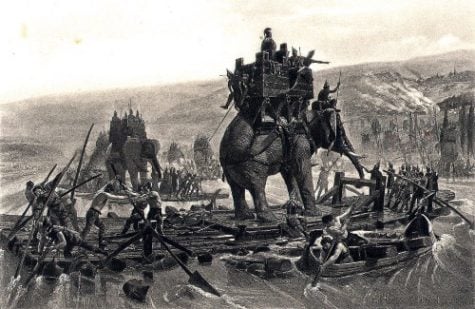
That scene in The Fellowship of the Ring, the one where Frodo and Sam cross the Brandywine, has always bothered me. How did hobbits, famously averse to water travel, know how to steer the raft? Wouldn’t they have been carried by the current a mile or two downstream?
In the book, Tolkien has Merry push off with a pole, but otherwise tells us nothing about how the flat ferry gets across. In illustrations, the other landing is usually directly across. How the heck did they manage to fight the current? The movie glosses over it even more obliquely.

This business with pushing a raft or barge with a pole assumes too much. First, it assumes the river has a more or less constant depth from one bank to the other. If it gets too deep, the pole won’t touch the bottom. If it’s too shallow, the raft runs aground. How many rivers do you know with these characteristics? Second, it assumes there never develops either a sandbar or a sinkhole, both of which are fairly common river events. Third, it assumes the river’s depth doesn’t change significantly with the seasons.
We’ll come back to this question of crossing via some sort of transport. First, let’s take the easy way.
Whatever You Can Af-ford
The oldest means of crossing a river is a ford. This sounds simple on the face of it: cross where the water ain’t. Finding a shallow spot in a river is an uncertain business, though. Your hero isn’t going to know where such spots are, and trial and error is both slow and dangerous. Moreover, just because a spot was fordable last year doesn’t mean it’s fordable this year; rivers have the dangerous trait of changing depth depending on time of year, and they change course over time.

Maps are all but useless because of this. True, there are some fords that have remained in place for years, decades, even generations, but most rivers shift their course over time, which means fordable crossings change as well. The medieval traveler would never trust a map without also checking with the locals.
So, our hero is going to have to ask the locals. This is fine, so long as you can trust them. There is more than one account where the locals have volunteered to an invading army that they know a “secret” ford a little further upstream. Few things are more catastrophic for an army than to be caught by the enemy mid-stream in deep water.
Moreover, asking the locals for such information is certainly going to draw some attention. Our hero might be better off working on his own. If the river is small enough, he can simply wade in. If he’s lucky, the water never rises above his knees, and he’s over. If he’s unlucky, he hits a sinkhole, loses his pack, loses his horse, maybe loses his life. He can try the same gamble on bigger rivers, but the risks go up. The speed of the current becomes a factor. A river in high flood can reach speed of 10 to 15 miles per hour, which is more than enough to sweep any creature off their feet, especially when the water gets above the creature’s knees. That’s true for everything from ponies to dragons.
The rule about knee-high works for wheeled vehicles as well. As long as the water is below the axle, you’re probably okay, but the real issue isn’t the cart, it’s the horse. Keep the water below the knees. If pressed, you can go deeper, but things get much more risky very quickly, and if the horse goes down, the wagon is lost.

I know, I know. Just use the road, dummy! If it’s a very important road, there will be a bridge, and that’s fine. For most places, though, the road simply crosses at a ford. See above.
Ferries
Which brings us back to the Brandywine. How did ferries actually work? Turns out, the answer is, in a variety of ways.
Row, Jimmy, Row
One of the simplest, and slowest methods was to row or paddle (anything from a hand paddle to a sweep oar) across. Sure. Fine.
But there’s a current, which means you are some way downstream by the time you reach the other bank. Some rivers run at five or six miles an hour and might be as much as a mile wide. Once on the other side, that same boat or barge has to get hauled back upstream in order to cross back to the original side. Let’s say you drifted two miles downstream. The boat has to get hauled not two miles but *four* miles back upstream, because it’s going to come back downstream as it crosses back over. Four miles towing against the current.
This was mitigated by steering upstream. You angle the boat upstream and let the push of the current move you across, rather like tacking into the wind with a sailing vessel. This required more skill and a good knowledge of the river. Ferrymen were just such folk; hobbits, not so much.
If you are trying to get an army across a large river, and you want any sort of realism, you need to take into account such calculations. You can turn this to advantage, slowing up an army however much you need, or adding drama to a crossing if the army is being pursued. Indeed, these ferry calculations are one reason why armies would march miles to reach a ford rather than try the more direct route. Ferry crossings are not only slow, they’re risky, for at some point you have most of your army on that side of the river with only a fragment on this side.
At a regular ferry service, there would most likely be two or more boats, which could speed things up considerably. Even so, at some point, most of your army is on one side while a mere fragment is on the side with the enemy. The Clever Writer will use this to his advantage.
Throw Me A Line
For smaller rivers, a better trick was to have a line that stretched across the river. The ferry could attach to that and use a combination of hauling and a sweep oar to navigate more or less directly back and forth. Quicker and cheaper. Keeping that line in place was a bother, though. If there was any traffic up and down the river, the rope technique would never be allowed. Even where it was allowed (usually non-navigable rivers), rope tends to rot.
One approach I saw for myself used a variation on this. The line was anchored well upstream, maybe a hundred yards. I think it was lashed to a tree. The little ferry boat held only about a dozen people. It had a fin rudder instead of a sweep oar, but that’s mainly because it was modern (this was in Bamberg, Germany). The pilot angled the rudder and the current moved the boat, and the line kept the boat from going downstream. That brought the ferry to the other landing, dead on. The same process brought it back again. The ferry operated like a pendulum. Very clever, so long as the load was not so great it tore out the line’s anchor.
Notable Crossings
Here are two examples of interest. The first concerns Hannibal. Everyone knows he crossed the Alps with elephants, which was no small feat for all that he lost many en route. Fewer people know about how he crossed the Rhône River. This river varies from nine to eighteen feet in depth and about thirty-five feet across (those are modern figures; it was probably wider and shallower in ancient times). Picture Hannibal standing on the right bank of the Rhône, with several dozen elephants at his back. How in the world is he going to get them across? While it is true elephants can swim, they won’t voluntarily just jump on in. What he did was build rafts. He not only built rafts, but he covered the rafts with turf, to make the animals feel more like they were on solid ground. He still lost a few, but it’s worth knowing that you can ferry even the largest of animals across a pretty substantial river.

The other example comes from the early 20th century, from the American West. There’s a crossing of the Snake River at a place called Three Islands. The following account comes from an autobiography of one of the last of the pioneers who came west by covered wagon.
The crossing had a ferry, operated by a local family. They demanded too much money, though. So the pioneer took pitch and sealed the wagon up. They unhitched the horses and swam these over, then used the wagon as a crude boat. It was swept some way downstream, but they got over to the other bank without mishap.
Both these examples are probably too specialized for direct use in your fiction, but maybe they will spark an idea or two.
Bucklebury Redux
So, to return to our hobbits. How did they get across? The most generous explanation would be this: the Brandywine at this particular point was at a big bend. In such bends, the current tends to slow, down to as little as a mile an hour. As it slows, a river also widens and gets shallower. So we can suppose the pole worked for most of the way across. We know these hobbits have little skill with boats, but I’ll allow that perhaps Merry heard from someone about the right way to navigate a ferry crossing. So, with a good deal of work (how long a pole could a hobbit handle, anyway?), we’ll let our heroes land on the opposite shore more or less where they intended.
For the Writer
Well, Tolkien has already used the most obvious angle–a chase sequence–but we can do variations on the theme. Returning to Hannibal, getting a whole army across a river is no small task. Think about how many soldiers you could put on a ferry, then how long it takes for the ferry to get over and back. Then realize that at some point, you have most of your army on one side while the enemy has superior numbers on the other. It’s best to cross where there is no enemy in sight, but you can always have the enemy show up at just exactly the worst time.
If it’s the chase sequence, have the crossing get fouled up in some way. The wagon (or ferry) capsizes. Pursuers turn up on *both* banks. Our heroes are attacked from air–or from the water, by crocodiles or hippos or river naiad. The long and the short of it here is, our heroes are in a peculiarly vulnerable position when crossing a river.
Finally, there’s always getting someone stuck, on a sandbar, in an eddy, caught by a submerged log. Since this is fantasy, there’s also getting attacked by some river monster. In any of these cases, it can be the hero in peril, or can be someone the hero rescues.
Hear From You
What great river crossings come to mind for you? Any from a fantasy story? Do you have a great idea for a scene? I’d love to hear from you!
About the Author:
E.L. Skip Knox is a writer and historian. He is the creator of the fantasy world called Altearth, a place where magic is real, monsters roam the land, and the Roman Empire never fell.
Publications include two novelettes (Mad House and The Garden of Hugo Vuerloz) and two short stories (“The Roadmaster” and “The Carrotfinger Man”). He is currently completing his first Altearth novel, Goblins at the Gates, and is writing another, A Child of Great Promise.
With an M.A. in Medieval History and a PhD in Early Modern History, Skip has been published in a Festschrift, in Asynchronous Learning Environments Magazine, and has four articles published by ABC-Clio. He has also presented several papers at Educom and other academic conferences.


I’m writing a historical novel set in 1752 with one particular scene where 20 families with the same number of heavy wagons are crossing the Raritan River in New Jersey.
I struggled with how to get them across until I noticed there was a significant bend in the river from an old map. I researched and found as you said, that the currents slow at the bend. But additionally, the banks were shallower there,
I had the party enter the shallower inside of the bend on one side, then traverse slightly downstream caused by the current to the opposite shallower inside bend.
I feel you are vastly underestimating hobbits. Yes, they are small and prone to laziness and overeating, but they are capable of everything any human is. They build their own homes, raise and train and ride horses, Grow their own food, make their own weapons and farm implements, etc etc.
Merry actually lived in Buckland, quite near the river in question; and his mother was a Took, a lineage of hobbits who lived near and had no fear of rivers and boats. The other hobbits often thought they were strange and foolish, and called them ‘river hobbits’.
Merry himself had crossed the river on that ferry many times, he had even crossed it alone several times.
Again, I think it’s not so much that the scene was unrealistic, but more that you don’t know what hobbits are capable of.
I was just thinking about this as I read the article:
The Bucklanders and Tooks spent a great deal of time on the Brandywine, and much is made of this in the books themselves. Frodo’s mother and father even died in a boating accident. Of all the Hobbits, only Sam had no love of the water and boats. Frodo, Merry, and Pippin knew how to handle them, and when the Fellowship traveled on the Anduin they took their turn helping to paddle the boats given to them by the Elves (Sam only helped out when they nearly ran into Sarn Gebir and it was All Hands On Deck to escape the rapids).
Also, it shows the writer’s ignorance of Tolkien himself. Tolkien fought in WWI, and had extensive, first-hand knowledge of how to move bodies of men from Point A to Point B, so I’m sure he knew exactly how ferries worked.
Ah…I remember the old Oregon Trail game. River crossings are dangerous! I’ve never crossed a river in my life unless you count walking downriver in knee-deep water to do some river fishing. My dad crossed a river in Yakima on one of those three-rope military bridges. That was pretty cool. Of course, my dog tried to follow him as he was suspended, and she rushed into the water and got swept away by the current and we had to find her downstream.
I love your picture of Merry! Write more hobbit articles! HA!
Eek, glad your dog was ok.
If I can find an angle, I’ll be sure to include more hobbits. 🙂
In our tabletop games (especially ones that were based on Middle-earth!), crossing a river (and other bodies of water, really) is one of Those Things That Just Are ARGH.
My character discovered that the new horse she had bought as her steed REALLY loved swimming, for example. We’re talking about a biggest Shire-horse sized thing here. She loves that horse, but the idea of approaching a body of water while on horseback makes her still break cold sweat and she’s faced a Balrog sword-to-flaming whip.
Then there was a time a different adventuring party was chased by a massive horde of attacking orcs, we were approaching a wide river we absolutely couldn’t swim across, and we could see our human ally army on the opposing shore, with campfires visible at night.
Our sharpest-eyed scout: Dang, they got boats there, I wish we could signal them to come and pick us up.
GM: Does anyone have any suitable communication skills?
Suddenly one of our slow-witted fighter types goes: Oh! Oh oh oh! I got “Military Signaling”, can I use that?
Our bacon was saved, but REALLY by smallest margin possible — we were about 1/3rd into crossing to safety when the enemies showed up and we still had to block some arrows with shield coverings. It was “fun” watching the orc army approach and friendly boats row closer, and you really could measure tension around the table.
In a different game (and system and setting), we also discovered why you really want to strip to lightest load possible and not wear armor while trying to cross a body of water. Instead of being an encounter with a monster that ends up a total party-kill, we nearly managed an almost total party-drowning, because our tanked up fighter nearly drowned people who tried to help him out of his own drowning. And the reason why he was wearing that armor (not JUST because Int was a dump stat) was fear of “what if there’s a monster in that river that’s gonna try to eat me”? (Again, the character was about as sharp as a box of hammers.)
Environment, when properly handled as a creative issue and given players lots of things to do in tabletop RPG, can be just as challenging as monsters and wicked people. We have had to deal with bad weather, flash floods, tornadoes, massive thunderstorms, massive heatwaves, blizzards, crossing marshes and bogs — all in a single campaign that was a fantasy equivalent of re-opening of local version of the Silk Road. Oh, and sometimes there were monsters involved, too — usually something that liked the changed conditions way too much and had us at disadvantage.
Sounds like you run a great game!
Your account of crossing at the last minute reminds me of a story about Emperor Frederick II. He was in Italy, pursued by enemies. He and his allies were camped at the Lambro River, evening, thinking they had got away safely, when the enemy forces showed up. They had more allies on the other side, but no time to come to his aid.
Frederick, with no armor, leaped onto a horse and let the horse swim him to safety on the other side. Yeah, he left his friends behind, but those are the risks when dealing with kings. 🙂 Very dramatic, though, complete with arrows flying over him as he lay close over the unsaddled horse’s back.
Great article and very good advice. On the whole, I’m adverse to adding realism to fantasy but a little here and there can’t hurt.
Like cologne. A little here and there can’t hurt; just be sure you don’t use too much. 🙂
Interesting post. I hadn’t thought about this, but you’re correct. One of the best points of advice I’ve received from publishing experts is to let things go wrong. A river crossing is perfect for that!
I’d have to go back and check, but I want to say C.S. Lewis handled this correctly in The Lion, the Witch, and the Wardrobe.
It’s been too long since I read that work, so I’ll take your word for it.
It’s funny, but if you think about it, Tolkien’s handling of the story at Bucklebury Ferry is almost the flip of that. Things had been going very, very wrong, and he uses the crossing as a way to set things right and give the characters a breather.
As a kid I kept hearing about Washington’s crossing of the Delaware river, and how important that was. What made it so significant, and how did he manage it?
Can’t help you there, Greybeard. I’m a medieval historian. I’m no good with modern stuff.